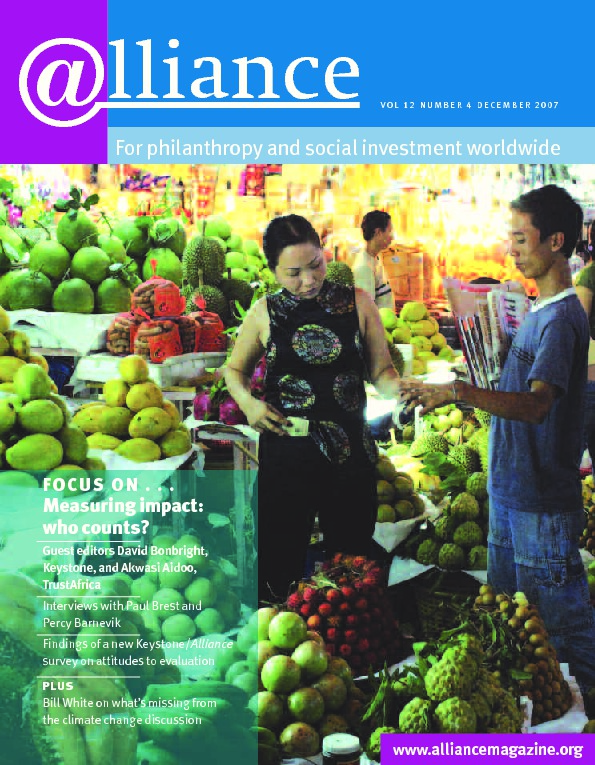Social Venture Technology Group (SVT) enables organizations to measure, manage and communicate the intangible value, or human impact, they create. While we use a variety of means, our core framework is social return on investment (SROI) analysis, which we see as an emerging management discipline, analogous to conventional accounting.
Our vision is that SROI analysis or its like will eventually be adopted by all organizations, and that the availability of this information will transform capital markets into engines for the creation of a thriving planet and healthy people.
Examples of SROI tools include: the Human Impact and Profit (HIP) Framework, used by companies to maximize return on sustainability expenditures and communicate results both internally and externally; and New Progressive Coalition’s Political Return on InvestmentTM (PROI) tool, which helps donors find non-profits in their personal interest area that provide a high ‘social’ return for their money.
About SROI
SROI analysis puts a disciplined frame around the questions ‘what social and environmental value do we create?’ and ‘how much does it cost us to do so?’ Instead of measuring the private financial costs and value created by the organization, as conventional accounting does, SROI analysis measures the costs and value for people and the planet created by the organization and relates them to the investment required. The non-financial costs and value include items that can be given a financial value (eg reduced carbon emissions), items that can be measured quantitatively (eg the number of vanished species that have returned to a region) and items that can only be measured qualitatively (eg the quality of life of individuals in the region). They also include a narrative aspect, eg chronicling how a group of waste pickers became entrepreneurs over a certain time period.
The deliverables of this analysis are analogous to both the balance sheet and the profit and loss statement. The ‘balance sheet’ is the SROI Report, which gives a snapshot of value created per unit of investment over a given period, plus, in SVT’s case, the RAP Graph,[1] which plots impact results against the management practices that drive those results. The profit and loss equivalent is the SROI scorecard, which assesses progress over a given time period against key indicators. Taken together, they allow an organization to see where it is in respect of what it wants to achieve.
By systematically measuring quantitative, qualitative and narrative information, it is possible to create a more accurate picture of the organization’s ‘value profile’, and to match investors and organizations whose value profiles are aligned.
In practice
The first step in SROI analysis is for the organization to clearly understand what change it aims to effect in a given area. Once this is done, SVT’s methodology involves, broadly speaking, defining the amount of the problem the organization believes it can literally solve to a certain measurable level, developing an impact value chain (the organization’s inputs, activities, outputs, outcomes and impacts), selecting appropriate indicators, and collecting and reporting on results, using the SROI Scorecard and Report.
A key challenge is balancing long-term goals (such as climate change abatement) with tangible milestones on the road to reaching them. Few firms will voluntarily undertake a second detailed accounting process, so SVT’s expertise is in finding the right balance between measurement credibility and organizational usefulness. SROI analysis also collects data from studies that have tracked similar interventions in order to obtain a proxy control group.
One of the most exciting implementations is that done by Sierra Gorda Ecology Group (SGEG), a community-based organization that co-manages a protected area in the mountains of central Mexico. SGEG has systematically measured its carbon emission reductions and other ecosystem impacts, and we worked with them to incorporate these environmental measures with social and economic indicators into an overarching SROI management framework. SGEG recently executed a trade on the voluntary carbon markets of carbon plus ecosystem services, at an effective 50 per cent premium above carbon alone. Its founder, Pati Ruiz Corzo, aims ultimately to offer a ‘gourmet product’ of carbon plus ecosystem services plus poverty alleviation for trade on the voluntary market. This would truly mean SVT’s vision of a market for social value creation had arrived!
1 Inspired by our work with Paul Herman, founder of HIP Investor.
Sara Olsen and Brett Galimidi are co-founders of SVT Group. Emails sara@svtgroup.net and brett@svtgroup.net
For more information
http://www.svtgroup.net
See p45 for Perla Ni’s comments on the five different approaches to evaluation outlined in the series of articles on pp40-44.




Comments (0)